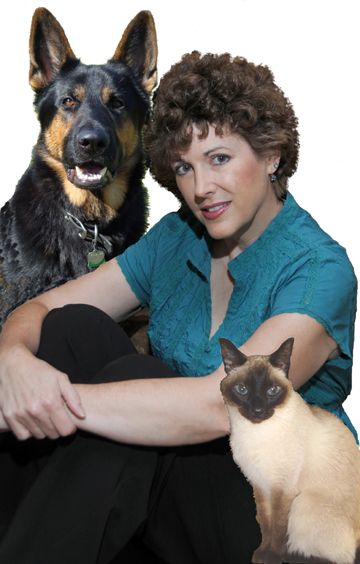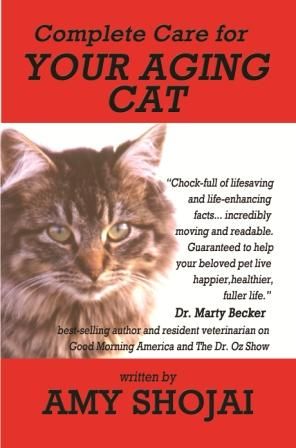Ark Animals is happily part of the Golden Moments Senior Pet Blog Tour which is helping Amy Shojai to promote her books, Complete Care for Your Aging Cat and Complete Care for your Aging Dog.
As part of the tour my subscribers were offered the opportunity to send Amy Shojai some of their questions.
In fact, Amy went wild in answering them and so we had to split this initial post into two parts! This is part one of Senior Pet Questions & Answers.
Many of the questions are explored in more detail in Complete Care for Your Aging Cat and Complete Care for your Aging Dog and the works also include advice directly from veterinarians and other experts.
Please note ©Amy Shojai, 2010. Amy Shojai is NOT a veterinarian and is here to share share her experience, along with recommendations gleaned from other experts.
We hope you will find this series of interest and will be motivated to purchase her works about aging pets and senior pets which have recently been made available in ebook format.
My vet just said she thinks my 17-year-old cat has arthritis in the right hip. What are natural options for treatment?
First off—wow! You must be doing something very right so far to have a 17-year-old kitty. Recent surveys indicate that 75 percent of senior cats have some degree of arthritis, so I’d be surprised if your kitty did not have some degenerative joint changes. Cats are so stoic, though, and such incredible athletes, that we rarely discover they have arthritis until it’s quite advanced. In fact, while dogs might hold up a paw and cry, or limp around so we notice, cats usually just…stop moving. They sleep more. We just think, “Fluffy’s getting old,” instead of wondering if there’s something wrong and if it’s treatable. It is treatable.
I’m sure you’re aware that giving cats pain medications can be very tricky—and only a vet should prescribe drugs. But there are things you can do at home. Treating arthritis for cats (or dogs) almost always means slimming down the tubby tabby. Too much weight puts extra strain on the joints, so the cat’s reluctant to move, which means kitty gains MORE weight—it’s a vicious cycle. So a healthy weight loss diet and slimming the cat is important. There are some excellent commercial “joint diets” now available for both cats and dogs.
Exercise lubricates and actually “feeds” the joints, so gentle exercise helps—put the cat food bowl on top of the cat tree or at the top of the stairs so Tabby must move to get the food. Heat relieves pain, so a heating pad under the cat’s bed, or a lamp over top, will make the kitty purr.
Massage also helps enormously, and if you have access to a practitioner, acupuncture works marvels with arthritis pain in pets (and cats and dogs don’t seem to care about the needles!).
Supplements (if you can get the cat to take them) also prove helpful, such as omega 3 fatty acids found in fish oils and green lipped mussels to reduce inflammation/pain. The glucosamine-type products that help people also help cats and dogs. The general dose is about 10 milligrams per pound of body weight, twice a day—so a 15-pound cat would get a total of a third of a 500-milligram capsule once each day.
How do you help an elderly toy dog with hip dysplasia? What can be done?
Many of the same recommendations for the arthritic cat also apply to a dog with hip dysplasia. Weight control and exercise are key. Swimming in warm water is a terrific doggy exercise! Omega 3 fatty acids, and glucosamine/chondroitin products are quite effective. There are also dog-specific pain medications available from your veterinarian that can help. Adequan is something to ask about, and has similar action to glucosamine/chondroitin.
What holistic or homeopathic method do you suggest for cats that have obsessive compulsive licking disorder, in other words they lick all their hair off? Some vets like to treat it with Kitty Prozac.
If the condition is a true OCD which can result from chemical brain changes, it may actually require drug therapy to break the cycle. It may take referral to a specialist (dermatology and/or behavior) to get the right diagnosis. In fact, some cats lick-lick-lick and remove all their hair over a particular spot—and eventually are diagnosed with having pain in that area, for example. Licking releases endorphins, natural pain killers, so it can become habit forming.
Psychogenic alopecia (the technical term) can be triggered by stress, though, and simply relieving/removing that stress can eliminate the self-barbering. The problem is—kitties naturally are bundles of nerves, and stress out sometimes over the most mundane situations like rearranging the furniture! The most common cause of stress in cats, though, is other cats.
For a specific recommendation I’d need to know more details. But in general, my top recommendations as a behavior consultant for relieving kitty stress are:
- Create a house of plenty (1+1 rule for litter boxes, feeding stations, cat trees, and more…that is one per cat, plus one).
- Pheromone therapy (Feliway or similar) that naturally reduces territorial anxiety.
- Bach Flowers remedies (such as Rescue Remedy) that can help address specific kinds of stress.
- Music therapy (such as harp music) that can be incredibly calming.
What are the signs that an animal has hit “senior” status?
There are physical signs, such as graying of the muzzle and ear rims, or cloudiness of the eyes. Luckily, pets don’t care about going gray! The senses become a bit more dim, and they’ll not see or hear as well as in their youth. Many dogs and cats develop creaky joints, so they’ll be unable or unwilling to exercise for as long, or be as athletic—they may avoid leaping onto beds or navigating stairs they bounded over in earlier years. Older pets have less capacity to “hold it” and often need more frequent bathroom breaks. There may be some personality changes, too. Old codger pets often are less patient and want to go out NOW, be fed NOW, and …will you quit pestering me, whippersnapper pup/kitten?!
That said, many pets age quite gracefully. Commercial pet food companies suggest that age seven is the benchmark for switching to a senior diet, but the numbers have less to do with it than function and attitude measures. Cats and toy dogs age more slowly and may not act aged until ten years or so.
Mid-size dogs might exhibit changes by seven or eight, while the giant-breed dogs age most quickly and might turn gray as early as five or six.
“Old age” is defined as the last 25 percent of a pet’s life, but since we can’t predict how long the pet will live, it’s at best a guesstimate. Today, because of the great care provided by loving owners and advances in vet medicine, many pets remain active, vital, and engaged in life virtually up to their last days.
 About the Guest Blogger: Amy Shojai (CABC) is a certified animal behavior consultant and author of 23 pet care books. She’s a spokesperson to the pet products industry, a columnist at About.com and CatChow.com, and appears as an expert on Animal Planet’s Cats 101 and Dogs101. She is also the host of Pet Peeves radio show on PetLifeRadio.com. You can learn more about her at the Amy Shojai website.
About the Guest Blogger: Amy Shojai (CABC) is a certified animal behavior consultant and author of 23 pet care books. She’s a spokesperson to the pet products industry, a columnist at About.com and CatChow.com, and appears as an expert on Animal Planet’s Cats 101 and Dogs101. She is also the host of Pet Peeves radio show on PetLifeRadio.com. You can learn more about her at the Amy Shojai website.



Thanks for stopping by Amy. We are holding a contest for subscribers and my Facebook and Twitter peeps. If you want to have any of your readers participate they can find it in my Discussions area.
Hi Diana,
Thanks so much for hosting me on my Senior Pet Blog Tour! I hope folks will comment/post additional questions (and I’ll be more succinct!). Enjoy the Q&As, folks, and let me know how you like the books.
best,
Amy Shojai